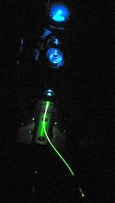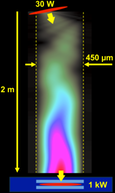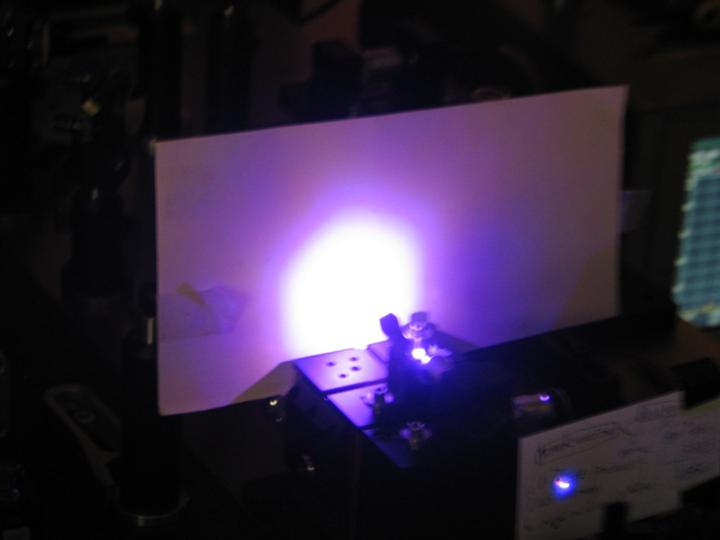Fibers and Optical Communications
Fiber Lasers at Exotic Wavelengths, Fiber Amplifiers
 Fiber lasers at exotic wavelengths: High-power, high-brightness, solid-state coherent light sources in the visible wavelengths are of great interest in laser material processing, home entertainment, opthamology, and much more. Fiber lasers excel in their power scaling ability and beam quality. However, most visible fiber lasers are based on fluorozirconate fibers which suffer from brittleness and hygroscopy. It is highly desirable to realize visible lasing in silica fibers, which are compatible with the established technology and components developed with the telecommunications industry. The Marciante group is studying exotic dopants in silicate fibers which potentially allow lasing at multiple visible wavelengths in one device. Current efforts encompass experimental characterization of fibers with such dopants, numerical simulation of its laser properties, and (in collaboration with Dr. Shibin Jiang from AdValue Photoincs) fabrication of fibers with novel designs.
Fiber lasers at exotic wavelengths: High-power, high-brightness, solid-state coherent light sources in the visible wavelengths are of great interest in laser material processing, home entertainment, opthamology, and much more. Fiber lasers excel in their power scaling ability and beam quality. However, most visible fiber lasers are based on fluorozirconate fibers which suffer from brittleness and hygroscopy. It is highly desirable to realize visible lasing in silica fibers, which are compatible with the established technology and components developed with the telecommunications industry. The Marciante group is studying exotic dopants in silicate fibers which potentially allow lasing at multiple visible wavelengths in one device. Current efforts encompass experimental characterization of fibers with such dopants, numerical simulation of its laser properties, and (in collaboration with Dr. Shibin Jiang from AdValue Photoincs) fabrication of fibers with novel designs.
SHARC Fiber Amplifiers: High power and high pulse energy fiber lasers and amplifiers require large-mode area fibers to spread the optical power and reduce the optical intensity to avoid detrimental noniear effects, such as stimulated Brillouin scattering.  However, modal discrimination in large-mode-area fibers becomes increasingly difficult with increasing core area. In collaboration with Dr. David Rockwell and Vladimir Shkunov from Raytheon, we are working do develop semi-guiding high-aspect-ratio-core (SHARC) fiber lasers and amplifiers. These fibers offer (i) a modal discrimination mechanism that does not rely on coiling the fiber; (ii) relative modal discrimination that is independent of the core area; (iii) compact coiling without impacting either the propagation loss, the mode content, or the spatial overlap of the fundamental mode with the gain profile; and (iv) record-breaking mode-area scaling beyond 10,000 μm2.
However, modal discrimination in large-mode-area fibers becomes increasingly difficult with increasing core area. In collaboration with Dr. David Rockwell and Vladimir Shkunov from Raytheon, we are working do develop semi-guiding high-aspect-ratio-core (SHARC) fiber lasers and amplifiers. These fibers offer (i) a modal discrimination mechanism that does not rely on coiling the fiber; (ii) relative modal discrimination that is independent of the core area; (iii) compact coiling without impacting either the propagation loss, the mode content, or the spatial overlap of the fundamental mode with the gain profile; and (iv) record-breaking mode-area scaling beyond 10,000 μm2.
Highly Nonlinear Fibers, Space-Time Duality, Space-Division Multiplexing, and Deep-Space Optical Communications
Highly nonlinear fibers are new types of fibers in which the effective mode area is reduced to enhance the nonlinear effects. This category includes tapered fibers, photonic crystal fibers, and microstructured fibers in which a narrow silica core is surrounded with a cladding containing multiple air holes. Professor Agrawal's group is studying new kinds of nonlinear effects such as supercontinuum generation inside highly nonlinear fibers. ![]()
Space-time duality is an exciting new research area in which mathematical similarity between diffraction and dispersion is explored for new short-pulse applications. Professor Agrawal is currently working with an Laboratory for Laser Energetics group to design a four-wave-mixing based temporal magnification system suitable for measuring the actual shape of asymmetric short optical pulses.
Space-division multiplexing: The use of multimode or multicore fibers can enhance the capacity of telecommunication systems though space-division multiplexing. Professor Agrawal's group is involved in studying the impact of various nonlinear effects on such systems.
Deep-space optical communications: NASA is interested in developing optical communication capability between earth and deep-space satellites. Professor Agrawal's group is involved in studying the possibility of amplification of laser light received at the satellite using vertical-cavity surface-emitting lasers before data is imposed on it.
Microstructured Fibers, Fiber Optomechanics, Multimode Solitons and Fiber Lasers
The fiber optical waveguide is a remarkable technology that is both essential for modern communication and responsible for an ever-increasing number of scientific innovations. Professor Renninger’s lab focuses on important nonlinear optical phenomena in a variety of optical fiber types. Microstructured photonic crystal fiber is investigated for its unique optical guidance properties and for its capability of supporting an array of optically active liquids and gases. Multiple fiber types are being explored for their ability to support acoustic waves, optical waves, and nonlinear optical interactions between them. Graded-index and multi-mode fibers are being investigated for their capability of supporting optical solitons and new higher-dimensional nonlinear optical behavior. Finally, the fiber laser, an exceptionally impactful technology which relies critically on the performance of single-mode, multi-mode, and large-
mode area fibers, is being actively investigated in the lab.
Photonic Crystal Fibers
Photonic crystal fibers are just one example of the new kinds of optical fibers that have been made recently. These fibers, together with holey fibers, and others can have exotic properties such as very high nonlinearity, engineerable dispersion, as well as custom doping to produce new nonlinear optical devices. The Knox group has developed a new way to manage the dispersion of these devices on a sub-millimeter length scale, and also novel ultrafast optics sources based on these novel fibers.
Slow-Light Techniques, Stimulated Light Scattering, Solition Propagation
Professor Boyd is interested in the use of slow-light techniques to perform buffering and optical storage for use in optical telecommunication systems. In addition, he is interested in the study of fundamental physical processes such as stimulated light scattering, soliton propagation, and the nature of the nonlinear response of optical fibers.

